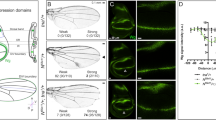Abstract
THE spatial organization of the Drosophila embryo depends on the activity of three axial pattern-forming systems. In addition to the anterior-posterior and dorsal-ventral systems that organize the segmented body plan1, a proximal-distal pattern-forming system is required to provide positional information for the developing limbs. The development of both the larval and adult limbs depends directly on the activity of the Distal-less gene2,3. Genetic analysis has shown that Distal-less functions as a developmental switch that is required to promote the development of limb structures above the evolutionary ground-state of body wall. Here we provide genetic evidence that indicates a graded requirement for Distal-less activity during limb development. Reduction of this activity has a global effect on pattern formation in the limb. The molecular structure of the Distal-less locus indicates that the gene encodes a homoeodomain-containing protein which is therefore likely to specify limb development through differential regulation of subordinate genes.
This is a preview of subscription content, access via your institution
Access options
Subscribe to this journal
Receive 51 print issues and online access
$199.00 per year
only $3.90 per issue
Buy this article
- Purchase on Springer Link
- Instant access to full article PDF
Prices may be subject to local taxes which are calculated during checkout
Similar content being viewed by others
References
Ingham, P. W. Nature 335, 25–34 (1988).
Cohen, S. M. & Jürgens, G. EMBO J., submitted.
Sunkel, C. E. & Whittle, J. R. S. Roux's Archs dev. Biol. 196, 124–132 (1987).
Campos-Ortega, J. & Hartenstein, V. The Embryonic Development of Drosophila melanogaster (Springer, Berlin, 1985).
Gehring, W. J. Science 236, 1245–1252 (1987).
Hall, M. N. & Johnson, A. Science 237, 1007–1012 (1987).
Balling, R., Deutsch, U. & Gruss, P. Cell 55, 531–535 (1988).
Barad, M., Jack, T., Chadwick, R. & McGinnis, W. EMBO J. 7, 2151–2161 (1988).
Mlodzik, M., Fjose, A. & Gehring, W. J. EMBO J. 7, 2569–2578 (1988).
Desplan, C., Theis, J. & O'Farrell, P. Nature 318, 630–635 (1985).
Hoey, T. & Levine, M. Nature 332, 858–861 (1988).
Driever, W. & Nüsslein-Volhard, C. Nature 337, 138–143 (1988).
Cho, K. W. Y. et al. EMBO J. 7, 2139–2149 (1988).
Müller, M. et al. EMBO J. 7, 4299–4304 (1988).
Beachy, P. A., Krasnow, M. A., Gavis, E. R. & Hogness, D. S. Cell 55, 1069–1081 (1988).
Hoey, T., Warrior, R., Manak, J. & Levine, M. Molec. cell. Biol. 8, 4598–4402 (1988).
Desplan, C., Theis, J. & O'Farrell, P. Cell 54, 1081–1090 (1988).
Oliver, G., Wright, C. V. E., Hardwicke, J. & DeRobertis, E. M. Cell 55, 1017–1024 (1988).
Savard, P., Gates, P. B. & Brockes, J. P. EMBO J. 7, 4275–4282 (1988).
Frohnhöfer, H. G. & Nüsslein-Volhard, C. Nature 324, 120–125 (1986).
Driever, W. & Nüsslein-Volhard, C. Cell 54, 83–93 (1988).
Driever, W. & Nüsslein-Volhard, C. Cell 54, 95–104 (1988).
Snodgrass, R. E. Principles of Insect Morphogenesis (McGraw-Hill, London, 1935).
Page, D. et al. Cell 51, 1091–1104 (1987).
Beveriey, S. M. & Wilson, A. C. J. molec. Evol. 21, 1–13 (1984).
Langer-Safer, P. R., Levine, M. & Ward, D. C. Proc. natn. Acad. Sci. U.S.A. 79, 4381–4385 (1982).
Otting, G. et al. EMBO J. 7, 4305–4309 (1988).
Pabo, C. O. & Sauer, R. T. A. Rev. Biochem. 53, 293–321 (1984).
Poole, S., Kauvar, L., Drees, B. & Kornberg, T. Cell 40, 37–43 (1985).
Fjose, A., McGinnis, W. & Gehring, W. J. Nature 313, 284–289 (1985).
Weinzierl, R., Axton, M., Ghysen, A. & Akam, M. Genes Dev. 1, 386–397 (1987).
Rushlow, C., Doyle, H., Hoey, T. & Levine, M. Genes Dev. 1, 1268–1297 (1987).
Saint, R., Kalionis, B., Lockett, T. J. & Elizur, A. Nature 334, 151–154 (1988).
Author information
Authors and Affiliations
Rights and permissions
About this article
Cite this article
Cohen, S., Brönner, G., Küttner, F. et al. Distal-less encodes a homoeodomain protein required for limb development in Drosophila. Nature 338, 432–434 (1989). https://doi.org/10.1038/338432a0
Received:
Accepted:
Issue Date:
DOI: https://doi.org/10.1038/338432a0
Comments
By submitting a comment you agree to abide by our Terms and Community Guidelines. If you find something abusive or that does not comply with our terms or guidelines please flag it as inappropriate.



